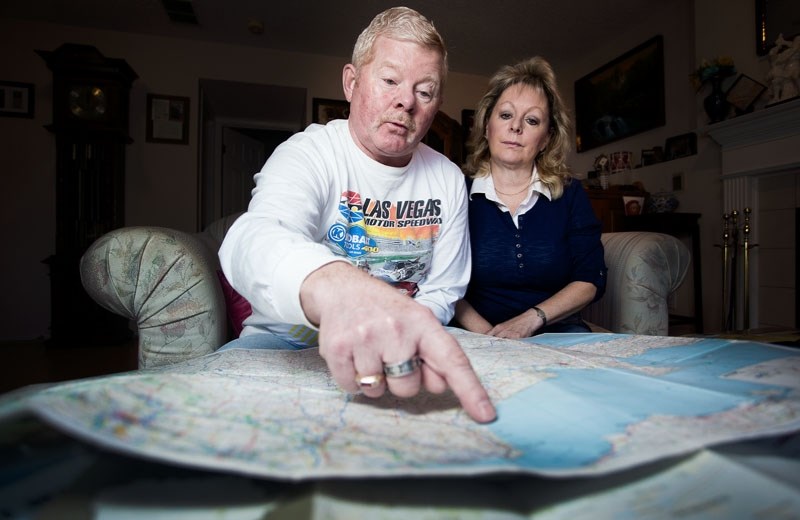In August and early September Doug and Leah Harbak travelled to France and Belgium to pay their respects at cemeteries from World War One and World War Two.
Often Doug, 59, wore his father's Legion jacket to which he had pinned his own medals earned from serving for more than 30 years in a number of Canadian regiments. Doug, a mechanic, served in Laar, Germany; Egypt, China and Bosnia, but his own visit to the battlefields of Europe was a different kind of remembrance in honour of other war veterans. Yet everywhere he visited, people came up to say, “Thank you.”
He was particularly moved when he visited the Menin Gate cemetery because he almost went to it in his civilian clothes but at the last minute changed into the Legion jacket in a restaurant washroom. Still wearing his medals, he pulled into a parking lot and went to pay but was told, “No charge.”
The Menin Gate Memorial has a service every night at 8 p.m. It is dedicated to the British and Commonwealth soldiers killed at Ypres, and whose graves are unknown.
“I wanted to go there because for several years I was in the Strathcona's Horse regiment. The names of all the Canadian fallen are on the memorial," said Doug.
On a different day, he and Leah visited the Juneau Beach D-Day memorial and on an impulse waded into the water to see what it might have been like for the Canadian soldiers who came ashore that day on June 6, 1944.
“We were out in the water on a sandbar at Juneau Centre, and a man from England waded out especially to say ‘Thanks for your service',” Doug said.
The Harbaks visited most of the 58 Commonwealth cemeteries, where Canada's war dead are buried. For the most part they visited cemeteries from the First World War and they chose to travel on a journey that roughly followed a time-line that matched the journey taken by the soldiers from 1914 to 1918.
They drove in a rented car, and though they had allowed two weeks for the trip, they came away with an ironic sense of time. The First World War lasted four long years, but the Harbaks were surprised to find they had seen all the cemeteries in less than a week.
"The battlefields were all very close. Often the trenches would be just 10 metres apart," Doug said, as he explained the trenches were above ground and the bunkers underground. The soldiers slept and ate in the bunkers and fought from the trenches. Victories were measured in metres, as the Allies and Germans progressed back and forth between trenches.
This year marked a special tribute to the soldiers from Newfoundland regiments who died in the First World War.
"There are five places called the Caribou Monuments and they are dedicated to the Newfoundlanders. In one battle 800 died," said Doug.
Finding the cemeteries they wanted to visit wasn't always easy, Leah said.
"The only marker was a little green sign, that said Commonwealth cemetery. Sometimes the cemetery was down a farmer's grass path. On one side there were carrots growing. On the other, turnips and in the middle a Canadian cemetery," she said.
Both the Harbaks were especially moved by their visit to Lieutenant Colonel John McRae's gravesite. McCrae, the author of the In Flanders Fields poem, died of pneumonia January 18, 1918 near Boulogne-Sur-Mer, France. The Harbaks had to ask someone where the grave was.
“We were looking for his grave but it's off the beaten track. It's just in a communal cemetery with other soldiers' graves. There is no special marker,” said Doug, who put a Canadian flag on the poet's grave.
Before they began their journey, Leah thought she might be depressed by visiting all the cemeteries and memorials, but instead, she came away with a new respect for history and with a sense of patriotism.
“It puts it into perspective, especially when you see the numbers of graves. There are thousands and thousands of them. On the First World War cemetery markers, sometimes there were two or three names. And at Juneau Beach, you see how the doors on the landing craft opened, and then ... they were in the water. And that was that. Some never even made it to the water,” she said.
Doug is putting together a collection of photos to show their family members. He has called the trip, “Walking in the footsteps of heroes.”
“When you think about it, all those soldiers were volunteers," said Doug. "They served three or four years.”
He highly recommends that other Canadians take the trip to Normandy and to Flanders Fields.
“It's easy to drive around and people there are very respectful. I highly recommend that others take the same journey,” Doug said.




